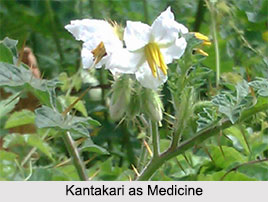 Kantakari is an invaluable medicine for Dropsy as a follow-up of the advanced stage of fever when all other modes of treatment fail. It is a powerful diuretic and useful in chronic, violent and low fever, dropsy or general anasarca, low vitality of the general system, enlargement of liver and spleen. It is combined with kurchi in anasarca with dysentery.
Kantakari is an invaluable medicine for Dropsy as a follow-up of the advanced stage of fever when all other modes of treatment fail. It is a powerful diuretic and useful in chronic, violent and low fever, dropsy or general anasarca, low vitality of the general system, enlargement of liver and spleen. It is combined with kurchi in anasarca with dysentery.
The root of Solanum Jacquinii is much esteemed as an expectorant and is used in cough, asthma, catarrhal fever and pain in the chest. It is an ingredient of Dasamula and is thus largely used in a great variety of diseases. The fruits are said to possess properties similar to those of the roots and are eaten as a vegetable.
Dose of Kantakari in Medicine
Kantakari is used in medicine in various forms, such as decoction, electuary, ghrita, etc. A decoction of the root is given with the addition of long pepper and honey in cough and catarrh, and with rock salt and asafoetida in spasmodic cough. Several compound decoctions made along with other expectorant and demulcent drugs are in use. The following is an example. Take Kantakari, root of Justicia Adhatoda (vasaka), pulse of Dolichos uniflorus (kulattha) and ginger, equal parts in all 2 tolas; prepare a decoction in the usual way and administer with the addition of pachak root in cough with difficult breathing.
Kantakaryavaleha: Take kantakari root 12 seers and a half, water 64 seers, boil till reduced to one fourth and strain. Boil the strained decoction till reduced to the consistence of a fluid extract and add to it the following substances in fine powder, namely, gulancha, Piper Chaba (chavya), plumbago root, tubers of Cyperus rotundus (mustaka), Rhus succedanea, ( karkata sringi), long pepper, black pepper, ginger, Alhagi Maurorum (yasa), Clerodendron Siphonanthus (vargi), Vanda Roxburghii, (rasna) and zedoary root, each 8 tolas, sugar 2 seers and a half, sesamum oil and clarified butter each 1 seer and boil together till reduced to the proper consistence. Lastly, add honey 1 seer, bamboo-manna and long pepper in fine powder, each half a seer. This electuary is given in various sorts of cough.
Kantakari Ghrita: This is prepared in the usual proportions with the fresh juice of kantakari, clarified butter and the following substances in the form of a paste, namely, Vanda Roxburghii (rasna), Sida cordifolia (bala) ginger, long pepper, black pepper and the fruits of Tribulus terrestris (Gokshura). It is used in same cases as the electuary.
Related Articles
Ayurveda
History of Ayurveda
Origin of Ayurveda
Ayurveda Medication
Elements of Ayurveda
Concepts of Ayurveda
Ancient Literature of Ayurveda
Sushruta Samhita




















